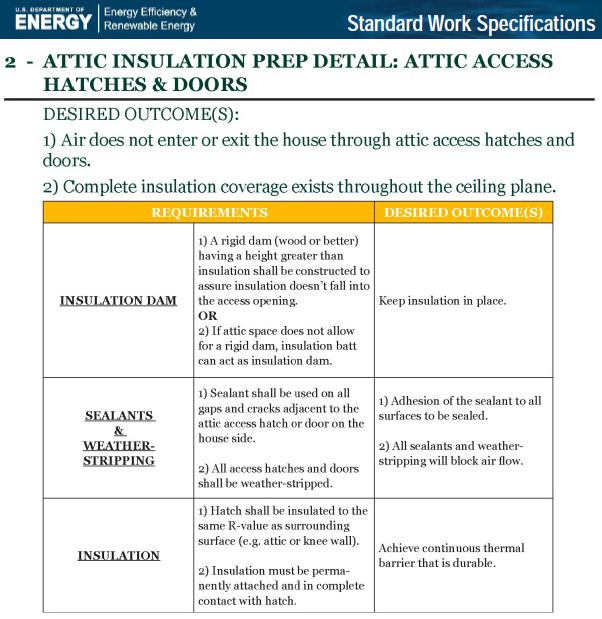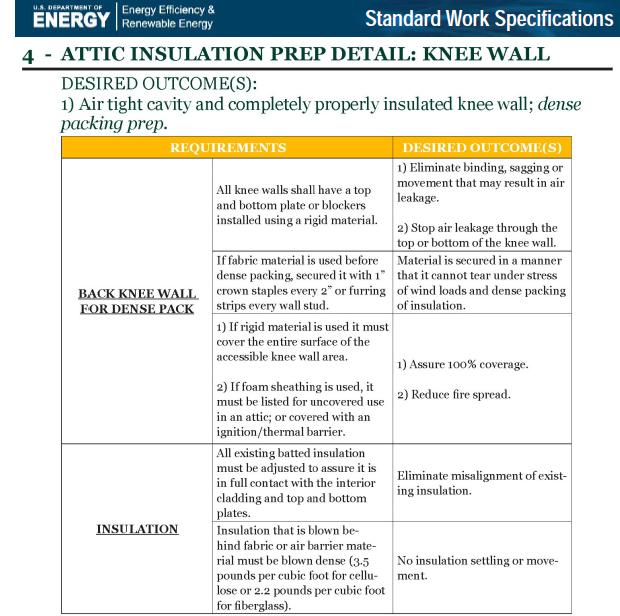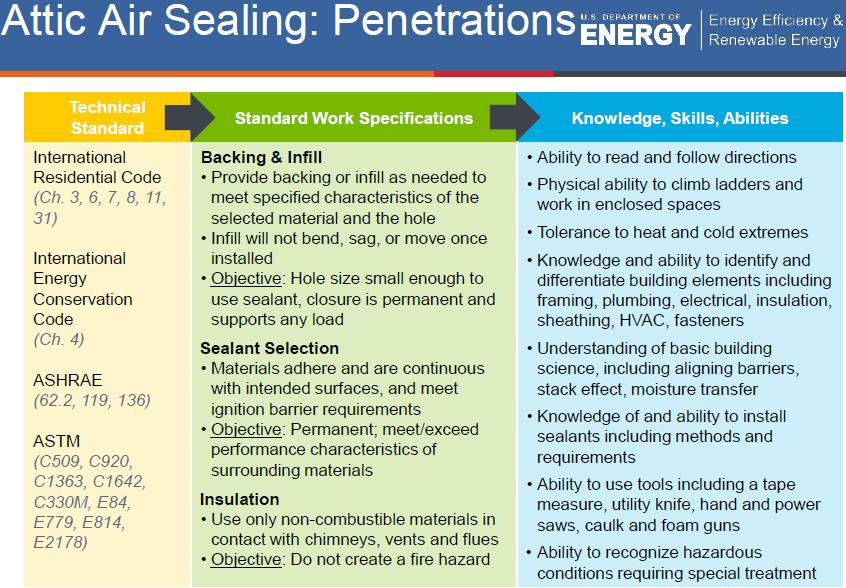 On Monday, I received an invitation to attend a webinar put on by DOE / NREL to attend a webinar entitled “National Residential Retrofit Guidelines: Update & Opportunities to Engage.” Hmmm, I had never heard of that and it sounded somewhat interesting. It also appeared at first glance to run after another webinar I was scheduled to attend by DOE on the ENERGY STAR® program, so why not? Unfortunately, they both happened to be slated for the exact same time (hint hint DOE – you might want to work on your scheduling a little). Well low & behold, the ENERGY STAR webinar had to be postponed as the Go2Meeting service experienced a major hiccup yesterday.
On Monday, I received an invitation to attend a webinar put on by DOE / NREL to attend a webinar entitled “National Residential Retrofit Guidelines: Update & Opportunities to Engage.” Hmmm, I had never heard of that and it sounded somewhat interesting. It also appeared at first glance to run after another webinar I was scheduled to attend by DOE on the ENERGY STAR® program, so why not? Unfortunately, they both happened to be slated for the exact same time (hint hint DOE – you might want to work on your scheduling a little). Well low & behold, the ENERGY STAR webinar had to be postponed as the Go2Meeting service experienced a major hiccup yesterday.
What is the NRRG?
Unless you work for DOE (Department of Energy), know or were 1 of the 140 industry experts, or 200 plus other individuals involved, the webinar yesterday or this blog article might be the first you have heard about it. The NRRG (National Residential Retrofit Guideline) is supposed to be a “Voluntary National Guideline” that is supposed to cover any energy efficiency retrofitting activity that happens on single-family properties. As an FYI – the slides used yesterday can be downloaded here.
What do they hope to accomplish, and why now?
Honestly, I think its best if I let them state their purpose; this quote and an associate timeline of their activities is available here.
The NREL-led process to develop these National Residential Retrofit Guidelines has involved a historic collaboration between Weatherization practitioners and trainers, home performance contractors, building scientists, organized labor, and other technical experts in the building trades and throughout the retrofit industry. The guidelines build upon the considerable (but until now incomplete) body of material already in circulation, and the cumulative knowledge gathered throughout the 30-year history of the energy efficiency retrofit industry.
Once completed, the Retrofit Guidelines will:
- Enable state and local weatherization officials and other residential retrofit program administrators to strengthen their field guides and other work manuals by incorporating the high quality Standard Work Specifications contained in the Retrofit Guidelines
- Assist training providers in developing course content and curricula consistent with an industry-recognized suite of Job Task Analyses
- Increase workforce mobility up career ladders and across career lattices by establishing a clear set of essential Knowledge, Skills and Abilities upon which worker credentials should be based
- Build confidence amongst consumers and the energy efficiency finance community that retrofit work will be completed in a quality manner and produce the expected energy savings and health benefits
- Lay the foundation for a more robust worker certification and training program accreditation architecture
What are the guidelines?
Well that is a good question, as only a handful of people really know at this moment. If you have already snuck a peak at either of those two links above – you may have noticed that they are not slated to be released until Sept. 30th when VP Biden releases them. As soon as they are released, there will be a very short time frame for us to review all 247 pages, and comment on them before they are go live sometime this fall. Fortunately, they actually did provide 2 of them on pages 19 & 20 so we can see what we have to look forward to.
Example 1 – Attic Hatches:
The desired outcomes are great; the implementation though – can you please explain to me how to achieve an R-60 on a hatch or door and still allow it to stay airtight & operable? Seeing the insulation has to be permanently attached, does that mean that we can no longer create or use a cover instead? These are just two of the items I see with this standard.
Example 2 – Attic Insulation Prep for a Knee Wall
Wow, an airtight cavity as a desired outcome – I take it no one studied physics… Insulation in bays must be adjusted so it touches everywhere, but nothing about compaction, fluffiness, or which side the Kraft paper goes? 1” Crown Staples – you have to be kidding me right? The largest I have ever seen spec’d by a manufacturer is ½” & it appears you forgot about the spacing from the edges of the wood.
What is a KSA?
KSA stands for Knowledge, Skills, & Abilities. It simply is a sheet, which is supposed to show everything that any employee is supposed to know and has to accomplish. You generally find these in larger corporations and of course in governmental agencies. Seeing they work so well there, they feel that every job should have one. In all their thoughtfulness, they actually provided us one on page 22.
Example 3 – KSA for Attic Air Sealing
Oh boy, where to start; hmmm, how about with the issues where the sealing is supposed to withstand “any” load, be permanent, and will not allow for any expansion (either from the item running through the hole, or the material around it. Yeah, physics folks… Oh boy, combustible materials must not touch a chimney, how about per code they should remain 3” away, or as listed in the manufacturers’ specifications?
The Real Issues per DOE:
DOE actually lists 5 issues why they feel that changes need to be made; #1 Lack of a credentialed workforce is an impediment for WAP and the home performance industry. #2 No nationally-recognized workforce credential for WAP and market-rate retrofits (impedes mobility.) #3 Wide range of WAP certifications across states. #4 Existing national certifications are based on KSAs in need of improvement. #5 No existing EE personnel certification entity accredited to ISO 17024 standard.
The Real Issues:
The real issues I think are truly shown in items #2 and #3, which revolves around the Weatherization Assistance Program itself, not the actual “home performance industry”, as they try to state in #1. I know plenty of contractors like myself, that looked at the programs & simply said no thanks – and this was after attending and paying for the “State Approved Training.” In my case, I had a few issues with the implementation, and saw the normal corruption & issues associated with federal programs. In many other locations, many contractors cannot get those jobs, or even a real chance at bidding because of the good ole boy network, has them locked up.
As for items #4 & #5, those are also misnomers. There are two “nationally recognized certifications” at this time which are recognized by… Drum Roll Please… by DOE itself. ENERGY STAR Verifiers like me have to be a RESNET Certified Rater. The second one is the HPWES program that requires BPI certification that we also happen to have. As for the ISO 17024 standard of certification conformity, it appears that both those groups are still pursuing that and have already implemented many of the items required.
(Updated: Official Announcment / Public Comment)




So…is this another way to get another government “consultant” on the payroll to put more companies out of work? I'm all for making sure that the quality of any construction project be up to par, but what about those of us already taking extreme care that simply can't afford all that extra investment in what are quite possibly needless steps? I'm interested in following it to see where the legislation goes on that.
Morning Amy, fortunatly it wouldn't affect you as a Timber Framer but you bring up some good points which I didn't have the space to get to. It quite simply is getting a little ludicrous, on how everyone should be certified or carded to do XY & Z. Do the cards really mean anything – not really, it just means someone passed the test – not that they can really do the work.
As an FYI – there is no legislation, it is a “voluntary national standard” which won't be so voluntary in years to come
I can’t agree more with both of you. This is going to be marketed as progressive and innovative, but when you really break it down, it is basically taking a step back because it will slow down a lot of good work being done across the country. It’s nice to have a voluntary standard that all homeowners should aim towards…but realistically, as you said, “it won’t be so voluntary in years to come.” Hopefully by then it will be cleaned up a bit. Really enjoyed this page by the way…
Sean, I agree with some of the technical issues you identified and hope that you will participate in the public comment period this fall. It’s always better to be part of the solution rather than part of the problem. BTW, Energy Star does not have anything to do with the DOE, in case you weren’t aware.
As an FYI, the edit was only the correction you mentioned in the second posting.
DOE doesn’t have anything to do with the Energy Star program for homes – you might want to explain that a little more as most of the “Energy Star” webinars are done by DOE which is listed just as prominently as the EPA on those sites
Sorry for typo. Should be “Energy Star does not have anything to do with the DOE…”
Perhaps a misunderstanding? The DoE does help promote ES for Homes. But all of the webinars I’ve participated in were developed and produced by ICF, which is the prime Energy Star contractor for the EPA. Among other things, ICF is responsible for outreach and training for the new Energy Star 2011 program. To my knowledge, the DoE is not involved in any Energy Star webinars, but I could be wrong.
Here’s a listing of the currently scheduled public webinars:
http://www.energystar.gov/index.cfm?c=bldrs_lenders_raters.nh_events_webinars
Energy Star 2011 training webinars are not linked on the ES website but instead are emailed directly to ES partners. Here’s a screenshot of the most recent promo I received from Energy Star:
So…is this another way to get another government “consultant” on the payroll to put more companies out of work? I'm all for making sure that the quality of any construction project be up to par, but what about those of us already taking extreme care that simply can't afford all that extra investment in what are quite possibly needless steps? I'm interested in following it to see where the legislation goes on that.
Morning Amy, fortunatly it wouldn't affect you as a Timber Framer but you bring up some good points which I didn't have the space to get to. It quite simply is getting a little ludicrous, on how everyone should be certified or carded to do XY & Z. Do the cards really mean anything – not really, it just means someone passed the test – not that they can really do the work. As an FYI – there is no legislation, it is a “voluntary national standard” which won't be so voluntary in years to come
I can’t agree more with both of you. This is going to be marketed as progressive and innovative, but when you really break it down, it is basically taking a step back because it will slow down a lot of good work being done across the country. It’s nice to have a voluntary standard that all homeowners should aim towards…but realistically, as you said, “it won’t be so voluntary in years to come.” Hopefully by then it will be cleaned up a bit. Really enjoyed this page by the way…
Sean, I agree with some of the technical issues you identified and hope that you will participate in the public comment period this fall. It’s always better to be part of the solution rather than part of the problem. BTW, Energy Star does not have anything to do with the DOE, in case you weren’t aware.
As an FYI, the edit was only the correction you mentioned in the second posting.
DOE doesn’t have anything to do with the Energy Star program for homes – you might want to explain that a little more as most of the “Energy Star” webinars are done by DOE which is listed just as prominently as the EPA on those sites
Perhaps a misunderstanding? The DoE does help promote ES for Homes. But all of the webinars I’ve participated in were developed and produced by ICF, which is the prime Energy Star contractor for the EPA. Among other things, ICF is responsible for outreach and training for the new Energy Star 2011 program. To my knowledge, the DoE is not involved in any Energy Star webinars, but I could be wrong.
Here’s a listing of the currently scheduled public webinars:
http://www.energystar.gov/index.cfm?c=bldrs_lenders_raters.nh_events_webinars
Energy Star 2011 training webinars are not linked on the ES website but instead are emailed directly to ES partners. Here’s a screenshot of the most recent promo I received from Energy Star:
Sorry for typo. Should be “Energy Star does not have anything to do with the DOE…”